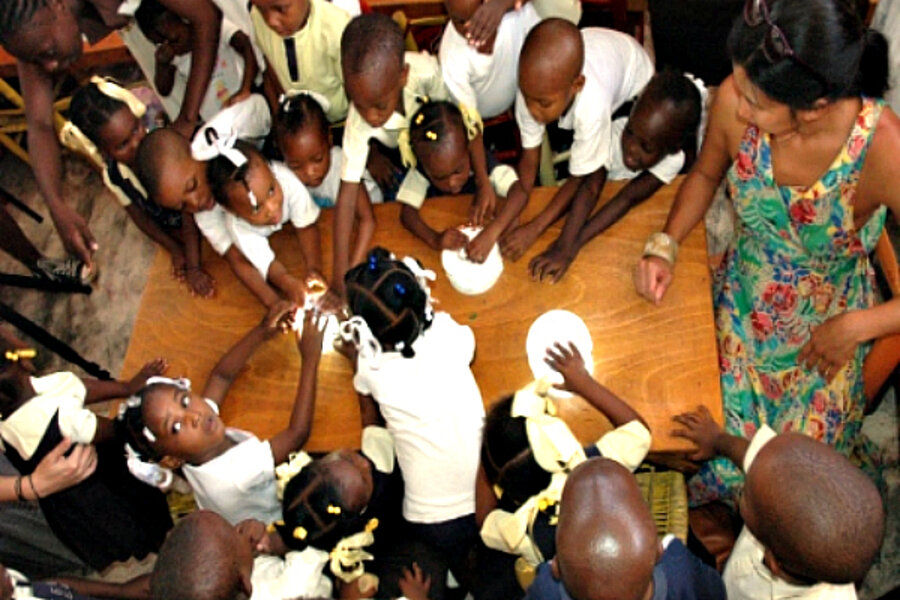Blow-up solar lantern lights up Haiti's prospects
Loading...
| RIO DE JANEIRO
What does sustainable development look like? It’s sitting in the palm of Jill Van den Brule’s hand.
She and a handful of other social entrepreneurs have come up with a blow-up solar-powered lantern that squashes flat like a child’s beach toy for easy transport. The elegant clear-plastic lantern has white LED lights that produce as much illumination as a 60-watt bulb, charges itself when left out in the sun, lasts a year, and costs $10 – a sum its inventors expect to be able to reduce.
“It cuts across a lot of problems,” says Van den Brule, who previously worked with United Nations children's agency UNICEF in Haiti following the country’s devastating 2010 earthquake and is now introducing the lanterns there.
RELATED: Top 5 nations that use renewable energy
Finding ways to create “energy for all” has been a focus at the Rio+20 sustainable development summit, which ended June 22 in Rio de Janeiro. The push, led by UN Secretary-General Ban Ki-moon, aims by 2030 to bring power to everyone around the globe, to double energy efficiency, and to double the share of renewable energy being used.
It has so far won commitments of more than $50 billion in private funding, as well as tens of billions of dollars of government, development bank, and civil society backing, UN officials said in Rio.
At least 1.3 billion people lack access to electricity, according to the International Energy Agency, and as many as 3 billion – half the planet – have only irregular access to power.
But a range of innovative efforts aim to change that – including projects like Luci, the solar lantern that Van den Brule is now rolling out with her partners at MpowerD, based in the United States and France.
Solar lanterns aren’t new – at least 10 are on the market today – but they will have a growing role to play in providing inexpensive and safe evening lights in parts of the world without the money or grid access for electricity, or in places looking for more sustainable sources of light, experts say.
Van den Brule said many children in Haiti study at night with kerosene lamps, which can cost at least $10 a month to run, produce toxic fumes, and can cause burns if knocked over.
Indoor smoke from cooking fires and lamps also contributes to nearly half of the world’s 2 million pneumonia deaths among children each year, and to cancer in women – two-thirds of female lung cancer victims in the developing world are nonsmokers, Van den Brule said.
The lanterns could also improve women's safety. Rape has been rampant in camps for families displaced following Haiti’s earthquake. But when lights were introduced into the camps at night, the number of rape cases per week fell from 57 to 2 in just one week according to UN statistics, Van den Brule said.
The lights used in the camp were not solar lanterns, but the value of access to portable lights at night, including for women or children going outside to toilets, is evident, she said.
There are other potential benefits. The lightweight lights could be included in kits for midwives. And the inventors are looking at creating a model that could also be used to charge mobile phones – a big demand in Haiti and many parts of the world – and at building the lanterns from recycled plastic bottles.
“We want the communities to come up with ideas of what they want,” Van den Brule said.
After early experimentation, a first batch of 10,000 lanterns are headed to Haiti soon, she said, and at least one UN agency is pondering carrying out a pilot project using them.
Van den Brule suspects the hand-held lights may eventually find another home in camping stores in the developed world and could even end up on fashion catwalks or hanging outside hotels to provide evening lights.
“We’re empowering communities but also creating things that are aesthetically nice,” she said. “There’s no reason something going to a developing country has to be ugly.”
• This article originally appeared at AlertNet, a humanitarian news site operated by the Thomson Reuters Foundation.
• Sign up to receive a weekly selection of practical and inspiring Change Agent articles by clicking here.





